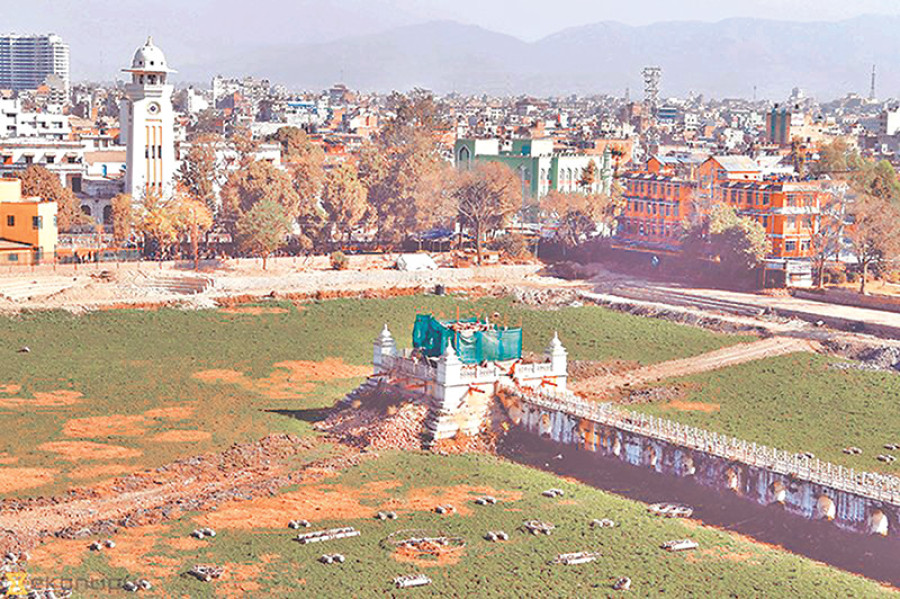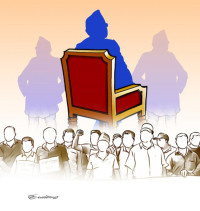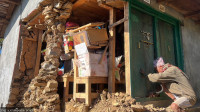Opinion
Wrong keeper of heritage
The reconstruction process of Rani Pokhari should have symbolised hope and revival, but this has hardly been the case
Prawash Gautam
King Pratap Malla tried everything he could think of, but his beloved, bereaved Queen’s heart could not be consoled. In desperation, he commissioned the construction of a pond to the east of the city and had a temple erected in the middle. Every evening, the Queen visited the temple, and slowly, surrounded by the pond’s serenity, her shattered heart began to come to terms with her young son’s death. Centuries later, the Valley’s denizens and its visitors saw in the pond the memories of a bereaved mother and a husband’s love. That pond was Rani Pokhari, and the temple was Bal Gopaleshwor.
Symbol of revival
When Nepalis were hit by the devastating earthquake that killed thousands and destroyed property and heritages sites, once again this monument of loss and healing served as a symbol of revival. Rani Pokhari was one of the many heritage sites in the Valley to face destruction.
That the government selected this pond as one of the heritage sites to initiate the reconstruction process, and that President Bidhya Devi Bhandari herself laid the foundation stones of its reconstruction further bolstered the idea that this monument could once again offer consolation and symbolise revival. But the reconstruction process over the past two years has been far from sacred.
Every site of historical and archaeological value reflects a certain period and architecture. This is indeed what makes a particular building, temple or structure a site of archaeological and heritage value. The particular knowledge, and dedication invested by the builders of these heritage sites are intrinsically linked to the visible structure.
When, upon the King’s command, the Newar masons and labourers dug out the pond and built the temple, concrete was not a material used in the construction of the temple that helped the Queen heal.
The Kathmandu Metropolitan City (KMC) sees concrete as the only material with which to rebuild the temple and the walls surrounding the pond. This departure from the original structure and materials do not reflect the spirit of love that drove King Pratap Malla to build the pond. And worse still is the KMC Mayor’s vision of converting the pond into an entertainment spot with a coffee shop and dancing fountains.
The KMC’s insistence to build the concrete wall around Rani Pokhari is deeply saddening to anyone who values and respects the heritage passed on by our ancestors, and the spirit embodied by these heritage sites.
The use of concrete pillars in the construction of the Bal Gopaleshwor Temple gave rise to criticism from conservation experts and the UNESCO, and led to the government ordering the KMC to hand over the temple’s reconstruction to the Department of Archaeology (DoA). Archaeologists, conservationists locals, cultural enthusiasts, individuals from almost all walks of lives have protested against the use of concrete in the rebuilding of the temple.
But the KMC remains unwilling to listen.
Patterns of disrespect
This case depicts one of the most severe instances of disregard shown to cultural heritage sites by the bodies that are most responsible for protecting them. But it would be wrong to think that this is the first time our society has been disrespectful of heritages. A look at heritage sites around Kathmandu which are abundant and found in almost every alley of this Valley will make it evident that the gigantic, ugly concrete structures built around them have no regard of the beauty and ambiance of the ancient, Newari architecture. Conservation of heritages and urban planning have been confined to policy papers which, so short of implementation, have gathered dust.
We have also failed miserably by doing damage to the Kathmandu Valley that once was. With its rich history and fertile land, the Valley in itself is a heritage. But it has turned into a concrete jungle today, whose agrarian value, potential, rich tradition and culture have been destroyed. The Rani Pokhari fiasco is merely the extension of this attitude.
But the direction now should be towards preservation through a change in this attitude. And this is where the KMC’s and Mayor Shakya’s attitude is appalling. One of the biggest groups that voted the Mayor to office were Newars of the same locality where Rani Pokhari is situated. Their ancestors built the pond. And in his campaign, he pledged to preserve the city’s culture and heritage. But he failed to make good on his pledge.
Engineers at the KMC told me that the use of concrete in the walls is the only option because the bottom of the pond is all sand for about 15 metres below ground. So, they say, concrete is the only way to prevent the water’s seepage. But the DoA says that the law forbids anything other than the use of traditional materials in the reconstruction and maintenance of heritage sites.
Traditionally, ponds in Kathmandu were constructed by laying black soil on the ground while the walls were built of bricks, mud, and typical reinforcement material prepared by the mixture of brick dust, lime, and caramel. Alok Tuladhar, a local campaigner protesting the use of concrete in Rani Pokhari told me that these materials can be easily used to reconstruct the pond’s walls using masons who have knowledge of the traditional way of building. Tuladhar and other local campaigners also brought a group of traditional masons from Bhaktapur to inspect Ranipokhari’s wall. They could build it in traditional form, they had assured. “There is no way Rani Pokhari cannot be built in its traditional form when Bhaktapur’s Siddha Pokhari and Kathmandu’s Kamal Pokhari could be reconstructed in a traditional way,” he said. He and locals and conservationists reiterated that Rani Pokhari cannot be destroyed in the name of strengthening it.
But this Mayor Shakya has a slightly different view when it comes to the definition of heritage. He is quoted as saying this while responding to concerns raised about Rani Pokhari reconstruction: “We shouldn’t keep sticking with something just because it belongs from the old times. Whatever new structures come into place, it becomes culture too. We shouldn’t say we’ll do whatever our ancestors did. We should accept change. We should accept new things.”
Kathmandu’s Mayor seems to hold views that are totally at odds with his constituents. Now, we should try to make him see through our eyes, and in the process protect the Valley from other such actions. We should start with Rani Pokhari.
- Gautam writes on social and cultural issues




 14.12°C Kathmandu
14.12°C Kathmandu










